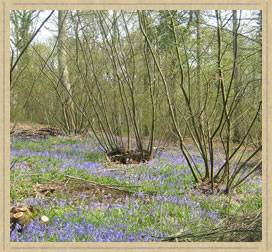Wildlife friendly management

Ash stool in a sea of bluebells

A ride through worked coppice

Coppicing work. (Click images to enlarge)
Ast Wood is a crucial island of bio-diversity, increasingly surrounded by intensive agriculture and horticulture. Such diversity has resulted from benign management over many centuries, harvesting useful woodland products by coppicing most of the trees at regular intervals (coppicing is cutting the growing poles off near the ground to grow again ), and allowing a few individual trees or standards - to grow to maturity for timber. The coppice remains as a changing but lower and thicker layer – or understorey - beneath the timber trees , and helps them grow straight and tall. Cleared tracks, known as rides, are usually maintained for easy movement through the wood, often around & between the patches of differently aged coppice, and attracting flowering plants and attendant species such as butterflies into their dappled shade. But diversity was threatened when coppice with standards management ceased, so today we aim to restore and enhance it by slowly adapting the currently uniform, oak-dominated high forest (resulting from recent decades of 'economic forestry-type' management) into a patchwork of differing woodland structures. Coppicing, thinning of standard trees, ride widening and shaping, glade creation, boundary hedgerow management, installation of bat roosting boxes and on-going species monitoring are all wildlife friendly aspects of our work.
Conservation
We do specific things to help conserve certain animal species, such as bats and dormice; we encourage particular plants like herb paris, and we have identified and labelled some eighty large trees as designated veterans-to-be.

These will be left to complete their natural life-cycles and thereby become increasingly valuable in wildlife terms. Sadly there are no very old trees in the wood at present, and an impressively large hawthorn specimen has recently been blown down. We also pay special attention to particular trees, including the wild service trees – Sorbus torminalis - nationally quite rare but common in some local woods, including Ast Wood.
Surveys
We are glad to host visits by a number of county and other wildlife survey groups, who almost always report interesting finds and who are creating valuable data banks on flowering plants, fungi, grasses and Old hawthorn sedges, and mammals.
